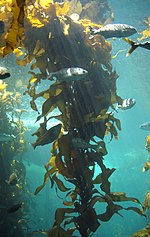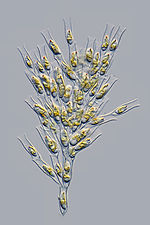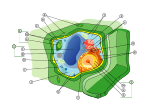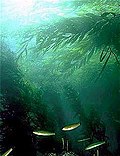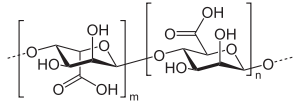Brown algae (sg.: alga) are a large group of multicellular algae comprising the class Phaeophyceae. They include many seaweeds located in colder waters...
59 KB (5,893 words) - 16:27, 11 October 2024
Green algae are a prominent examples of algae that have primary chloroplasts derived from endosymbiont cyanobacteria. Diatoms and brown algae are examples...
92 KB (10,575 words) - 19:43, 6 November 2024
Edible seaweed (redirect from Culinary algae)
belong to one of several groups of multicellular algae: the red algae, green algae, and brown algae. Seaweeds are also harvested or cultivated for the...
30 KB (2,624 words) - 09:29, 11 November 2024
chrysophytes, chrysomonads, golden-brown algae or golden algae, are a large group of algae, found mostly in freshwater. Golden algae is also commonly used to refer...
16 KB (1,596 words) - 10:06, 11 October 2024
their red color. Despite their name, red algae can vary in color from bright green, soft pink, resembling brown algae, to shades of red and purple, and may...
62 KB (6,198 words) - 08:18, 5 November 2024
Protists in the fossil record (section Brown algae)
apicomplexans, most ciliates, some green algae (the Klebsormidiales), choanoflagellates, oomycetes, brown algae, yellow-green algae, Excavata (e.g., euglenids). Some...
70 KB (7,729 words) - 07:09, 4 January 2024
There are many types of algae that are commonly found in a freshwater aquarium setting. Species may be unintentionally disseminated through spores and...
14 KB (1,489 words) - 15:34, 12 October 2024
Ochrophyte (section Harmful algae)
diverse lineages of eukaryotes, containing ecologically important algae such as brown algae and diatoms. They are classified either as phylum Ochrophyta or...
41 KB (4,136 words) - 18:52, 16 October 2024
Fucus is a genus of brown algae found in the intertidal zones of rocky seashores almost throughout the world. The thallus is perennial with an irregular...
18 KB (1,766 words) - 21:37, 24 October 2024
single-celled, but some are multicellular including some large seaweeds, the brown algae. The group includes a variety of algal protists, heterotrophic flagellates...
33 KB (3,303 words) - 12:05, 31 August 2024
occurred in the red and brown algae). Diplobiontic green algae include isomorphic and heteromorphic forms. In isomorphic algae, the morphology is identical...
27 KB (2,663 words) - 17:15, 26 October 2024
Kelps are large brown algae or seaweeds that make up the order Laminariales. There are about 30 different genera. Despite its appearance, kelp is not...
42 KB (5,140 words) - 14:07, 2 October 2024
Macrocystis (redirect from Brown kelp)
Macrocystis is a monospecific genus of kelp (large brown algae) with all species now synonymous with Macrocystis pyrifera. It is commonly known as giant...
34 KB (4,032 words) - 22:17, 15 September 2024
non-photosynthesizing plants are heterotrophic. In contrast, green plants, red algae, brown algae, and cyanobacteria are all autotrophs, which use photosynthesis to...
3 KB (216 words) - 06:15, 20 May 2024
Green and Brown Algae of the Hawaiian Islands. Bishop Museum Press. ISBN 9781581780307. Blust, Robert; Trussel, Stephen (2010). "*limut: moss, algae". Austronesian...
22 KB (798 words) - 09:51, 28 October 2024
had placed the blue-green algae (or Phycochromacea) in Monera; this would gradually gain acceptance, and the blue-green algae would become classified as...
74 KB (4,819 words) - 10:10, 4 November 2024
It is a herbivore that feeds on brown algae, but its close relative A. californica feeds almost exclusively on red algae. This difference in food sources...
8 KB (959 words) - 14:45, 7 June 2024
cellulose and hemicellulose. They appear to be the closest relatives of the brown algae. The species now placed in the Xanthophyceae were formerly included in...
18 KB (1,595 words) - 23:03, 18 October 2023
invalid. Still, he kept fungi within Protoctista, together with red algae, brown algae and protozoans. This classification was the basis for Whittaker's...
102 KB (10,569 words) - 13:29, 11 November 2024
Kelp forest (redirect from Algae forest)
normal population regulation and result in the overgrazing of kelp and other algae. This can rapidly result in transitions to barren landscapes where relatively...
87 KB (8,702 words) - 04:26, 11 November 2024
In archaeplastidans: some green algae (e.g., Cladophora glomerata, Acetabularia) In stramenopiles: some brown algae (the Fucales, however, their life...
24 KB (2,968 words) - 19:12, 7 November 2024
Alginic acid (category Brown algae)
called algin, is a naturally occurring, edible polysaccharide found in brown algae. It is hydrophilic and forms a viscous gum when hydrated. When the alginic...
21 KB (2,232 words) - 10:08, 12 October 2024
Fucoxanthin (category Brown algae)
an accessory pigment in the chloroplasts of brown algae and most other heterokonts, giving them a brown or olive-green color. Fucoxanthin absorbs light...
9 KB (826 words) - 03:44, 2 September 2024
brown algae, red algae, green algae, and plants. It evolved repeatedly for plants (Chloroplastida), once or twice for animals, once for brown algae,...
60 KB (6,271 words) - 04:42, 20 August 2024
biological processes by which photosynthetic organisms, such as most plants, algae, and cyanobacteria, convert light energy, typically from sunlight, into...
110 KB (11,776 words) - 06:13, 7 November 2024
Ascophyllum (category Monotypic brown algae genera)
inflammation and speed up healing, especially after a serious injury. Brown algae contains fucoidans, which are sulfated, fucose-rich polymers. Fucoidans...
28 KB (3,252 words) - 01:11, 1 November 2024
only six eukaryotic lineages: animals, symbiomycotan fungi, brown algae, red algae, green algae, and land plants. Eukaryotes are grouped by genomic similarities...
61 KB (6,102 words) - 11:22, 19 October 2024
Cyanobacteria (redirect from Blue-green algae)
cyanobacteria's informal common name, blue-green algae, although as prokaryotes they are not scientifically classified as algae. Cyanobacteria are probably the most...
180 KB (17,735 words) - 20:18, 6 October 2024
Turbinaria is a genus of brown algae (Phaeophyceae) found primarily in tropical marine waters. It generally grows on rocky substrates. In tropical Turbinaria...
21 KB (2,303 words) - 07:53, 19 May 2024

